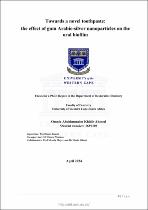| dc.description.abstract | Background: Oral health is an integral part of overall health and wellbeing of a human
being. Over 3 billion people worldwide suffer from poor oral health or dental disease. Oral
disease may cause discomfort, pain, disfigurement, tooth loss and loss of function. Untreated
oral disease may lead to decreased work productivity in adults, loss of school days for children,
economic burden to families, and reduced quality of life. Oral disease includes a range of
chronic clinical conditions such as dental caries, periodontal disease and oral cancer. The most
prevalent disease in the world is dental caries, which is becoming more prevalent, especially
in countries with low and moderate incomes.
Caries has a strong microbial association. Hence, measures of microbial control of
microorganisms need to be included in continued research on caries prevention. Multidrug
resistant microbes against existing antibiotic drugs is a challenge in health care, including
dentistry. The development and evaluation of new technologies is essential to overcome these
problems. Nanotechnology has emerged as an important innovation assisting in the provision
of health care. When compared to bulk molecules, nanoparticles (NPs) have powerful physical
properties. They are solid nanometer-sized particles (100 molecules in size). Recently, interest
in the use of nanotechnology has increased in dentistry as cutting-edge techniques for
preventing and treating dental caries as well as regulating oral biofilms. It has been established
that silver nanoparticles (AgNPs) have the potential to be used to create new antibacterial
agents, drug delivery systems, biomaterials, and regeneration materials, in addition to their
wide scope of medical applications. The synthesis of AgNPs can either be from inorganic or
organic sources. The biosynthesis of AgNPs from organic sources such as plant extract is
preferable due to their accessibility, renewability, biocompatibility, environment-benign
nature, and cost effectiveness. Consequently, the author investigated the use of gum Arabic
(GA) plant extract to synthesize AgNPs because of its ubiquity on the African continent, its
sustainability and its known medicinal value. | en_US |

